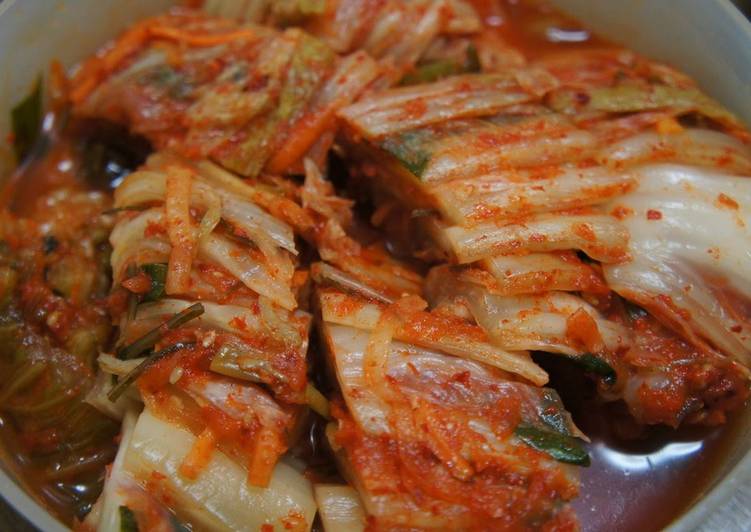Our Homemade Authentic Kimchi. Making kimchi, using a 'secret' recipe that was handed down through generations, is like making your grandma's apple pie with her secret recipe. Every woman has a different way of making it and there is a sense of pride and mystery that shroud a good kimchi recipe. So here is my 'secret', ridiculously easy authentic Korean kimchi recipe.
 Use a persimmon in place of the apple, if you prefer. Once you've become a kimchi master, you can dig into classic dishes like Kimchi Fried Rice, Spicy Beef and Kimchi Stew, and Pork and Kimchi Dumplings, or get creative with some recipes like Kimchi Grilled Cheese, French Fries with Bulgogi and Caramelized Kimchi, and Kimchi Sesame Hummus. The easiest and best way to mix kimchi is to push your hand all the way to the bottom of the bowl and fold the kimchi over on itself. You can cook Our Homemade Authentic Kimchi using 17 ingredients and 11 steps. Here is how you achieve that.
Use a persimmon in place of the apple, if you prefer. Once you've become a kimchi master, you can dig into classic dishes like Kimchi Fried Rice, Spicy Beef and Kimchi Stew, and Pork and Kimchi Dumplings, or get creative with some recipes like Kimchi Grilled Cheese, French Fries with Bulgogi and Caramelized Kimchi, and Kimchi Sesame Hummus. The easiest and best way to mix kimchi is to push your hand all the way to the bottom of the bowl and fold the kimchi over on itself. You can cook Our Homemade Authentic Kimchi using 17 ingredients and 11 steps. Here is how you achieve that.
Ingredients of Our Homemade Authentic Kimchi
- Prepare of whole Chinese cabbage.
- Prepare of A) Daikon.
- You need of whole A) Carrots.
- Prepare of bunches A) Chinese chives.
- You need of B) Red chili peppers (coarsely ground).
- You need of B) Red chili peppers (finely ground).
- You need of C) Apples.
- It's of C) Garlic.
- Prepare of C) Ginger.
- Prepare of C) Honey.
- Prepare of C) Sugar.
- You need of C) Cut kombu.
- Prepare of C) White sesame seeds.
- You need of Dashi stock granules.
- You need of Salt.
- Prepare of Water.
- It's of Salt-fermented shrimp paste.
Then, rub the top layer to better distribute the spices. Do this until the kimchi is sufficiently mixed. Photo by Shelby McLennan So many Korean dishes are made with well-fermented kimchi, such as kimchi jjigae, kimchi mandu, kimchi bibim guksu, kimchi fried rice, kimchi jeon, tofu kimchi, and many more. It starts with one large Napa Cabbage.
Our Homemade Authentic Kimchi step by step
- A freshly picked cabbage is hard to cut through, so let it rest in a dark place for about half a day. Once wilted a little, cut into 6 to 8 pieces..
- Sprinkle salt on the cabbage cores and start filling the barrel with them. Once filled, cover with about 1.5 times the weight of the 10 kg of cabbage..
- During the winter, all the liquid should come out within a day..
- Take out the cabbage and rinse well with water..
- Squeeze out the liquid piece by piece and let sit for a while. Then, squeeze out the liquid once more from the core to the leaves..
- Finely julienne the daikon and carrots marked with A). Cut the A) chives into 3 cm pieces..
- Bring 1.4 liter of water to a boil and add the dashi granules. Once cooled, add in the C) ingredients, apples, garlic, grated ginger. Add in the B) ingredients and shrimp paste..
- Mix well and let sit for about 30 minutes. Add in the A) ingredients and mix together. Now you have the yangnyeom sauce..
- Take the cabbage pieces from Step 5 and smear the yangnyeom sauce between each leaf..
- Arrange the cabbage pieces in a container..
- To seal off air, cover with plastic wrap and store in the refrigerator. It will be ready to eat in 3 days at the earliest, depending on your preference..
You'll need ginger, garlic, scallions and most importantly Korean Chili Flakes called Gochugaru. In this recipe, I use Korean Chili Flakes called "Gochugaru" vs. the Korean fermented Chili Paste called "Gochujang". Feel free to use Gochujang if you please or if. Kimchi is a unique and traditional fermented ethnic food of Korea, which consists of cabbage, salt, vinegar, and various spices. Although you can readily purchase kimchi in stores, it is often loaded with ingredients that aren't beneficial to the body, and can be incredibly high in salt.
Comments
Post a Comment